Whether animals are looking for food or mates, or avoiding pathogens and predators, they rely on biosensors—molecules that allow them to sense and respond to their environments. Christina Dawn Smolke, Ph.D., a professor of bioengineering at Stanford University in California, focuses her research on creating new kinds of biosensors to receive, process, and transmit molecular information. Her lab has built RNA molecules, or switches, that can alter gene expression based on biochemical changes they detect.
Continue reading “Scientist Interview: Exploring the Promise of RNA Switches with Christina Dawn Smolke”Posts by Abbey Bigler-Coyne
The Maternal Magic of Mitochondria
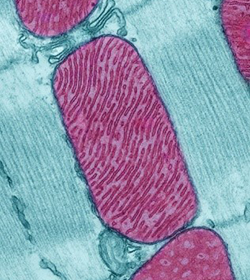 Mitochondria (purple) in a rodent heart muscle cell. Credit: Thomas Deerinck, National Center for Microscopy and Imaging Research.
Mitochondria (purple) in a rodent heart muscle cell. Credit: Thomas Deerinck, National Center for Microscopy and Imaging Research.
Mitochondria (mitochondrion in singular) are indispensable. Every cell of our bodies, apart from mature red blood cells, contains the capsule-shaped organelles that generate more than 90 percent of our energy, which is why they’re often called “the powerhouse of the cell.” They produce this energy by forming adenosine triphosphate (ATP), our cells’ most common energy source. But mitochondria also support cells in other ways. For example, they help cells maintain the correct concentration of calcium ions, which are involved in blood clotting and muscle contraction. Mitochondria are also the only structure in our cells with their own unique DNA, which with rare exceptions, is inherited only from mothers. That’s why, in honor of Mother’s Day, we’re exploring this special cellular connection to moms.
Continue reading “The Maternal Magic of Mitochondria”Cool Images: The Hidden Beauty Inside Plants
Spring brings with it a wide array of beautiful flowers, but the interior structures of plants can be just as stunning. Using powerful microscopes, researchers can peek into the many molecular bits and pieces that make up plants. Check out these cool plant images from our Image and Video Gallery that NIGMS-funded scientists created while doing their research.
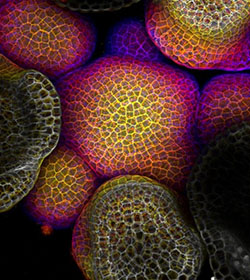 Credit: Arun Sampathkumar and Elliot Meyerowitz, California Institute of Technology.
Credit: Arun Sampathkumar and Elliot Meyerowitz, California Institute of Technology.
In plants and animals, stem cells can transform into a variety of different cell types. The stem cells at the growing tip of this Arabidopsis plant will soon become flowers. Cellular and molecular biologists frequently study Arabidopsis because it grows rapidly (its entire life cycle is only 6 weeks), produces lots of seeds, and has a genome that’s easy to manipulate.
Continue reading “Cool Images: The Hidden Beauty Inside Plants”All About Grants: Basics 101
Note to our Biomedical Beat readers: Echoing the sentiments NIH Director Francis Collins made on his blog, NIGMS is making every effort during the COVID-19 pandemic to keep supporting the best and most powerful science. In that spirit, we’ll continue to bring you stories across a wide range of NIGMS topics. We hope these posts offer a respite from the coronavirus news when needed.
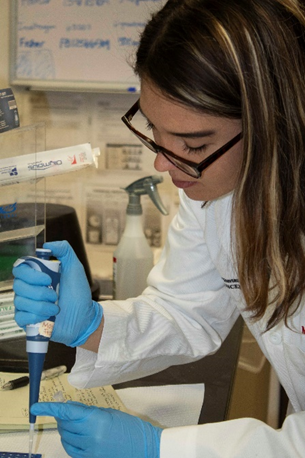 Scientific research requires many resources, which all require funding.
Scientific research requires many resources, which all require funding.Credit: Michele Vaughan.
Scientific inspiration often strikes unexpectedly. The Greek mathematician and inventor Archimedes first thought of the principles of volume while taking a bath. Otto Loewi designed an important experiment on nerve cells based on a dream involving frog hearts.
But going from an initial moment of inspiration to a final answer can be a long and complex process. Scientific research requires many resources, including laboratory equipment, research organisms, and scientists’ time. And all of this requires funding. Government grants support the majority of research in the United States, and the main source of these grants for biomedical researchers is the National Institutes of Health (NIH). NIH is the primary federal agency for conducting and supporting basic, clinical, and translational medical research. It investigates the causes, treatments, and cures for both common and rare diseases.
Explore Our Virtual Learning STEM Resources
If you’re looking for engaging ways to teach science from home, NIGMS offers a range of resources that can help.
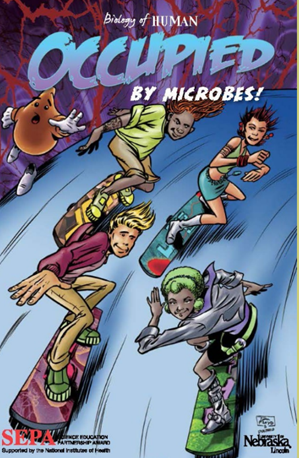 A SEPA-funded resource about microbes. Credit: University of Nebraska, Lincoln.
A SEPA-funded resource about microbes. Credit: University of Nebraska, Lincoln.
Our Science Education and Partnership Award (SEPA) webpage features free, easy-to-access STEM and informal science education projects for pre-K through grade 12. Aligned with state and national standards for STEM teaching and learning, the program has tools such as:
- Apps
- Interactives
- Online books
- Curricula and lesson plans
- Short movies
Students can learn about sleep, cells, growth, microbes, a healthy lifestyle, genetics, and many other subjects.
Continue reading “Explore Our Virtual Learning STEM Resources”PECASE Honoree James Olzmann Investigates the Secrets of Lipid Droplets
Note to our Biomedical Beat readers: Echoing the sentiments NIH Director Francis Collins made on his blog, NIGMS is making every effort during the COVID-19 pandemic to keep supporting the best and most powerful science. In that spirit, we’ll continue to bring you stories across a wide range of NIGMS topics. We hope these posts offer a respite from the coronavirus news when needed.
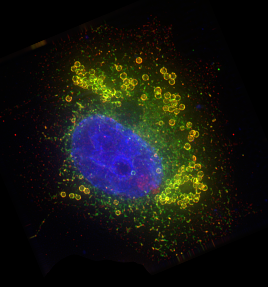 A cell nucleus (blue) surrounded by lipid droplets (yellow). Credit: James Olzmann.
A cell nucleus (blue) surrounded by lipid droplets (yellow). Credit: James Olzmann.
Within our cells, lipids are often stored in droplets, membrane-bound packages of lipids produced by the endoplasmic reticulum. For many years, scientists thought lipid droplets were simple globs of fat and rarely studied them. But over the past few decades, research has revealed that they’re full-fledged organelles, or specialized structures that perform important cellular functions. The field of lipid droplet research has been growing ever since.
Continue reading “PECASE Honoree James Olzmann Investigates the Secrets of Lipid Droplets”Revealing a Piece of Cilia’s Puzzle
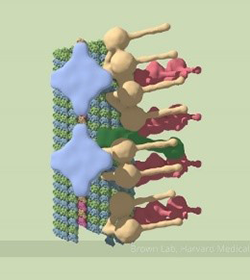 A partial model of a doublet microtubule. Credit: Veronica Falconieri.
A partial model of a doublet microtubule. Credit: Veronica Falconieri.
Cilia (cilium in singular) are complex organelles found on all of our cells except red blood cells. Their rhythmic beating moves fluid or materials over the cell to help transport food and oxygen or remove debris. For example, cilia in our windpipe prevent bacteria and mucous from traveling to the lungs. Some pick up signals like antennae, such as cilia in our ears that help detect sounds. One component of cilia is the doublet microtubule, a major part of cilia’s skeleton that gives it strength and rigidity.
Continue reading “Revealing a Piece of Cilia’s Puzzle”Pathways: The Circadian Rhythms Issue
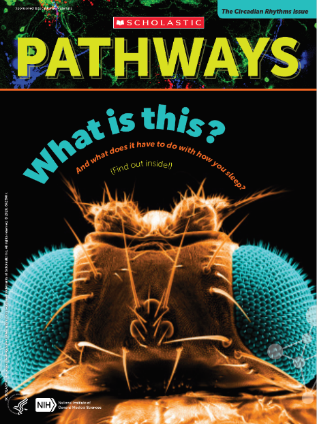 Cover of Pathways student magazine.
Cover of Pathways student magazine.
NIGMS and Scholastic, Inc., bring you the third edition of Pathways, a collection of free resources that teaches students about basic science and its importance to health, and exciting research careers.
Pathways is designed for grades 6 through 12. The topic of this unit is circadian rhythms, the “schedules” our bodies follow over the course of a day. These rhythms influence processes like hunger and the sleep-wake cycle.
Continue reading “Pathways: The Circadian Rhythms Issue”PECASE Honoree Sohini Ramachandran Studies the Genetic Foundations of Traits in Diverse Populations
 Sohini Ramachandran, Brown University.
Sohini Ramachandran, Brown University.Credit: Danish Saroee/Swedish Collegium for Advanced Study.
Recent advances in computing enable researchers to explore the life sciences in ways that would have been impossible a few decades ago. One new tool is the ability to sequence genomes, revealing people’s full DNA blueprints. The collection of more and more genetic data allows researchers to compare the DNA of many people and observe variations, including those shared by people with a common ancestry.
Sohini Ramachandran, Ph.D., is director of the Center for Computational Molecular Biology and associate professor of biology and computer science at Brown University in Providence, Rhode Island. She is also a recent recipient of the Presidential Early Career Award for Scientists and Engineers (PECASE). Dr. Ramachandran researches the causes and consequences of human genetic variations using computer models. Starting with genomic data from living people, her lab applies statistical methods, mathematical modeling, and computer simulations to discover how human populations moved and changed genetically over time.
Continue reading “PECASE Honoree Sohini Ramachandran Studies the Genetic Foundations of Traits in Diverse Populations”The Chemistry of Chocolate
Chocolate is a Valentine’s Day must-have and popular among people with a sweet tooth. Many also claim it lifts mood or even acts as an aphrodisiac, and we’ve all heard someone say it’s habit forming.
The compounds in chocolate that allegedly have positive effects come from the cacao bean, so the darker the chocolate, the more of these compounds it contains. Milk chocolate has less than dark chocolate, and white chocolate has nearly none because it includes no cocoa solids, only cocoa butter.
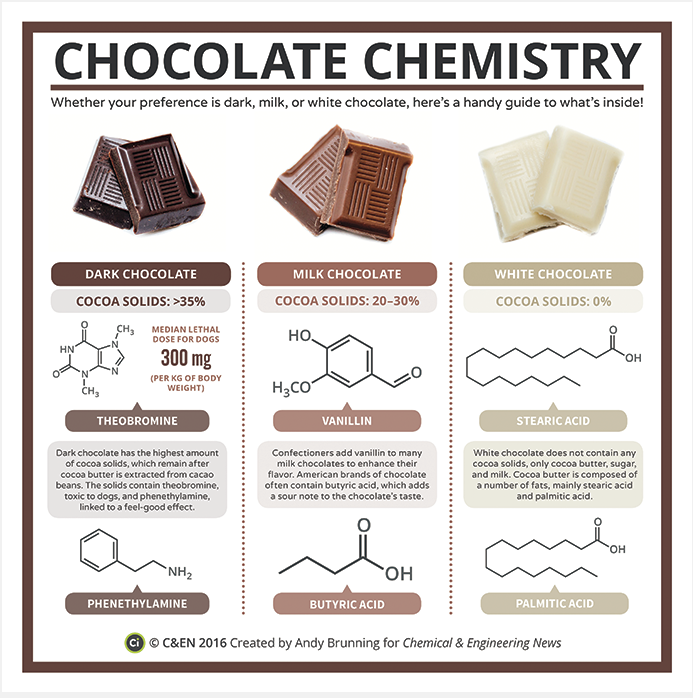 Chocolate contains upwards of 800 chemical compounds, just a handful of which are explored in this infographic. See more chemistry infographics like this one in C&EN’s Periodic Graphics collection. Click to enlarge
Chocolate contains upwards of 800 chemical compounds, just a handful of which are explored in this infographic. See more chemistry infographics like this one in C&EN’s Periodic Graphics collection. Click to enlarge
Does science back up the common claims about chocolate? To find the answers, we’re taking a look at the chemistry behind this treat.
Continue reading “The Chemistry of Chocolate”
